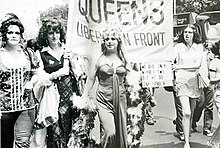Queens Liberation Front
 Queens Liberation Front members (center: Lee Brewster) marching in New York City in 1973. Source: Transgender Archive | |
| Founded | October 31, 1969 |
|---|---|
| Location | |
Key people | Lee Brewster and Bunny Eisenhower |
Formerly called | Queens |
Queens Liberation Front (QLF) was a homophile group primarily focused on transvestite rights advocacy organization in New York City. QLF was formed in 1969 and active in the 1970s. They published Drag Queens: A Magazine About the Transvestite[1] beginning in 1971. The Queens Liberation Front collaborated with a number of other LGBTQ+ activist groups, including the Gay Activists Alliance and the Street Transvestite Action Revolutionaries.[2]
Formation
[edit]Queens Liberation Front was founded as Queens by Lee Brewster in 1969.[3]: 83 At his first ball in February 1969, Brewster announced plans to form the group, with October 31, 1969 (Halloween, a particularly popular holiday in the drag community) to be its formal founding date.[4]
The organization was founded in part to oppose the relegation of drag queens to the back of the March at the first Christopher Street Liberation Day in June 1970. In protest, the street queens from STAR moved to the front and marched at the front of the parade anyway.[5][6]
Activities
[edit]Queens Liberation Front participated in many activities to advocate for the rights of LGBT people, particularly transvestites.[7] The organization also participated in LGBT events such as the LGBT Pride March.[3]: 113 [8] Members sometimes wore drag while lobbying New York state legislators.[6]
The organization often collaborated with other local LGBT organizations, such as Gay Activists Alliance and Street Transvestite Action Revolutionaries.[8][9]
In the early 1970s, the organizations successfully used litigation to overturn a New York City ordinance against cross-dressing.[3]: 87
In 1973, Queens Liberation Front agreed to a compromise amendment to New York City's anti-discrimination ordinance that added sexual orientation to the ordinance, but clarified the ordinance did not cover cross-dressing. The organization's director, Bebe Scarpie, met with the bill's sponsor at City Hall and agreed to the compromise. The organization's lawyer, Richard Levidow, believed the exclusionary clause violated the United States Constitution and was therefore unenforceable.[10]
Lesbian Feminist Liberation opposed the performance by drag queens at the 1973 NYC Pride March in New York City. As they passed out flyers, Sylvia Rivera, of Street Transvestite Action Revolutionaries, took the microphone from emcee Vito Russo and spoke against this sentiment, delivering a speech about spending time in jail, and being harassed and beaten by the straight men who were preying on all the members of the gay community. Rivera ended by leading a chant for "Gay Power!"[5] Lesbian Feminist Liberation's Jean O'Leary then read a statement on behalf of 100 women that read, in part, "We support the right of every person to dress in the way that she or he wishes. But we are opposed to the exploitation of women by men for entertainment or profit."[11] Queens Liberation Front's Lee Brewster replied in support of drag and the drag queens in the community. The increasingly angry crowd only calmed when Bette Midler, who heard on the radio in her Greenwich Village apartment, arrived, took the microphone, and began singing "Friends". This was one of several events in early 1970s where lesbian feminists, gay men, and drag queens at times found themselves in conflict; while other events, such as those led by the GLF women's caucus, often had harmonious participation between these sometimes contentious factions.[3]: 113 [12][13][14]
See also
[edit]- Gay Activists Alliance
- History of lesbianism in the United States
- LGBT culture in New York City
- List of LGBT people from New York City
- NYC Pride March
- Street Transvestite Action Revolutionaries
References
[edit]- ^ "Drag Vol. 1 No. 1 (1971) - Digital Transgender Archive". www.digitaltransgenderarchive.net. Retrieved September 22, 2020.
- ^ Drag. Digital Transgender Archive. Queens Publications. 1971.
{{cite book}}: CS1 maint: others (link) - ^ a b c d Stein, Marc (2012). Rethinking the Gay and Lesbian Movement. Routledge. ISBN 9780415874106. Retrieved June 30, 2015.
- ^ "Lee Brewster Dies at 57 – Pioneering Transvestite Activist". Gay Today. Retrieved June 30, 2015.
- ^ a b Rivera, Sylvia, "Queens In Exile, The Forgotten Ones" in Street Transvestite Action Revolutionaries: Survival, Revolt, and Queer Antagonist Struggle. Untorelli Press, 2013.
- ^ a b Stryker, Susan (January 7, 2009). Transgender History. Seal Press. p. 87. ISBN 9780786741366. Retrieved June 30, 2015.
- ^ Hanhardt, Christina B. (November 13, 2013). Safe Space: Gay Neighborhood History and the Politics of Violence. Duke University Press. p. 124. ISBN 9780822378860. Retrieved June 30, 2015.
- ^ a b Cohen, Stephen (November 21, 2007). The Gay Liberation Youth Movement in New York. Routledge. p. 142. ISBN 9781135905682. Retrieved June 30, 2015.
- ^ Glisson, Susan M. (2006). The Human Tradition in the Civil Rights Movement. Rowman & Littlefield. p. 325. ISBN 9780742544093. Retrieved June 30, 2015.
- ^ "Interview With an Actual Stonewall Riot Veteran: The Ciswashing of Stonewall Must End!". The TransAdvocate. February 18, 2013. Retrieved June 30, 2015.
- ^ Jean O Leary Lesbian Feminist Liberation 1973 Pride Rally. Event occurs at 00:30. June, 1973. Accessed Oct 13, 2015.
- ^ Sycamore, Mattilda (April 22, 2008). That's Revolting!: Queer Strategies for Resisting Assimilation. Soft Skull Press. ISBN 9781593763145. Retrieved June 28, 2015.
- ^ Shepard, Benjamin Heim and Ronald Hayduk (2002) From ACT UP to the WTO: Urban Protest and Community Building in the Era of Globalization. Verso. pp.156-160 ISBN 978-1859-8435-67
- ^ Photos of Gay Liberation Front Demonstrations by Diana Davies at the New York Public Library Digital Collection. Accessed 17 May 2019
